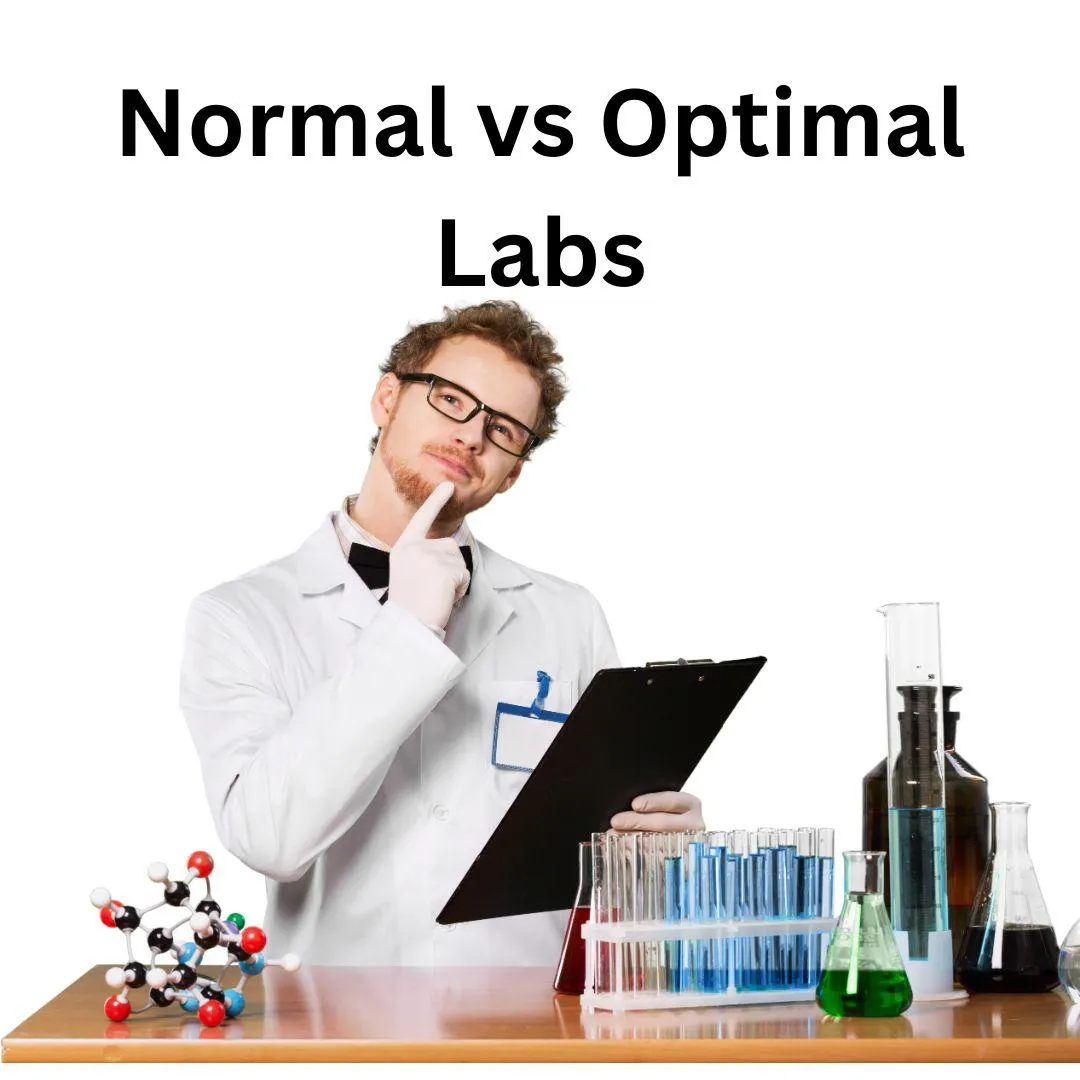*Open to Florida Residents
Blog
Blog

Understanding Normal vs. Optimal Lab Values and Their Impact on Well-Being
Lab tests play a pivotal role in modern healthcare, offering critical insights into your body’s inner workings. When we receive tests results, they are typically accompanied by a reference range, often termed “normal values.” However, what is deemed “normal” might not always align with what is “optimal” for an individual’s health and well-being. This blog explores the distinction between normal and optimal lab values and examines how striving for optimal ranges can enhance overall health.
Normal Lab Values: The Statistical Average
Normal lab values are derived from large population studies. These ranges encompass the results of most individuals in a specific demographic group, such as age, sex, or ethnicity. For example, if a blood test result falls within the 95% confidence interval of a population sample, it’s often categorized as “normal”. While this approach provides a broad benchmark, it has inherent limitations:
Population Variability: Normal ranges can vary across laboratories due to differences in equipment, methods, and reference populations.
Statistical Outliers: Being within the normal range doesn’t necessarily guarantee health, just as being slightly outside it doesn’t always i indicate disease.
Broad Spectrum: Normal ranges often represent a wide spectrum of values, which may include states of suboptimal health.
Optimal Lab Values: Personalized Precision
Optimal lab values are narrower ranges tailored to support peak physiological function and prevent disease. These values often reflect what’s considered ideal for health, vitality and longevity. Functional medicine practitioners and wellness focused healthcare providers frequently emphasize optimal values to identify and address potential imbalances before they manifest as disease.
Key Differences Between Normal and Optimal Values
Aspect Normal Values Optimal Values
Definition Statistical average from Values associate
a population sample with peak health
and function.
Approach Reactive (detects Proactive
disease states) Prevents disease enhances vitality
Range Broader, often Narrower, target
including suboptimal for well-being
states
Personalization Generic Individualized
Optimal Vs Normal Lab Values
Examples of Normal vs Optimal Ranges
1. Vitamin D (25-Hydroxy):
Normal: 20-50 ng/ml
Optimal: 40-60 ng/ml
Impact: Suboptimal levels may still fall within the normal range but could contribute to fatigue, bone weakness, or immune dysfunction.
2. Thyroid Stimulating Hormone (TSH):
Normal:0.5-5.0 ulU/ml
Optimal: 0.5-2.0ulU/ml
Impact: Individuals with TSH levels in the upper end of normal range might experience symptoms of hypothyroidism, such as weight gain or fatigue.
3. Fasting Blood Glucose:
Normal: 70-99mg/dl
Optimal: 70-85mg/dl
Impact: Even within the normal range, elevated glucose levels can indicate early insulin resistance, increasing the risk of type 2 diabetes.
Why Optimal Values Matter
Achieving and maintaining optimal lab values can:
Enhance Energy Levels: Optimal nutrient levels, such as iron or vitamin B12, support energy production and reduce fatigue.
Boost Immunity: Maintaining optimal levels of immune-supportive nutrients, such as vitamin D and zinc, can reduce susceptibility to infections.
Improve Mental Clarity: Balanced hormones and glucose levels are crucial for cognitive function.
Prevent Chronic Diseases: Early detection of suboptimal levels can prevent progression to conditions like diabetes, cardiovascular disease, or osteoporosis.
Support Longevity: Optimizing biomarkers like inflammation markers such as CRP, and lipid profiles contributes to longer, healthier life.
Several factors can affect an individual's lab results, highlighting the importance of personalized interpretation.
Age and sex: Hormone levels, such as testosterone or estrogen, naturally fluctuate with age and vary between sexes.
Diet and Lifestyle: Nutrient intake, physical activity, sleep quality, and stress levels significantly impact biomarkers.
Medical Conditions: Chronic illnesses or acute infections can skew lab results.
Medications: Some drugs influence lab values, such as statins altering lipid profiles or diuretics affecting electrolyte levels.
The Role of Functional Medicine: Interpreting Lab Results
Functional medicine emphasizes understanding lab results in the context of an individual's overall health. This approach includes Comprehensive testing which goes beyond basic panels to include markers like inflammatory cytokines, advanced lipid profiles, and micronutrient levels. It involves looking at the root cause and identifying underlying factors contributing to suboptimal values. Plus, developing tailored plans involving dietary adjustments, supplements, lifestyle changes and when necessary, medications.
What Practical Steps Can You do to Achieve Optimal Lab Values
Regular Testing: Periodic lab work helps monitor trends and detect imbalances early.
Targeted Nutrition: Consuming a diet rich in whole, nutrient dense foods supports optimal biomarker levels.
Lifestyle Optimization: Incorporating exercise, stress management techniques, and adequate sleep promotes overall health.
Supplementation: When dietary intake is insufficient, targeted supplements can help achieve optimal ranges.
Professional Guidance: Working with a healthcare provider ensures safe and effective interventions.
In conclusion, understanding the difference between normal and optimal lab values empowers you to take charge of your health proactively. While normal values provide helpful baseline, striving for optimal levels can significantly enhance well-being, prevent disease, and promote longevity.
Disclaimer:
This content is for informational and educational purposes only. It is not intended to provide medical advice or to take the place of medical advice or treatment from a personal health care professional.

Understanding Normal vs. Optimal Lab Values and Their Impact on Well-Being
Lab tests play a pivotal role in modern healthcare, offering critical insights into your body’s inner workings. When we receive tests results, they are typically accompanied by a reference range, often termed “normal values.” However, what is deemed “normal” might not always align with what is “optimal” for an individual’s health and well-being. This blog explores the distinction between normal and optimal lab values and examines how striving for optimal ranges can enhance overall health.
Normal Lab Values: The Statistical Average
Normal lab values are derived from large population studies. These ranges encompass the results of most individuals in a specific demographic group, such as age, sex, or ethnicity. For example, if a blood test result falls within the 95% confidence interval of a population sample, it’s often categorized as “normal”. While this approach provides a broad benchmark, it has inherent limitations:
Population Variability: Normal ranges can vary across laboratories due to differences in equipment, methods, and reference populations.
Statistical Outliers: Being within the normal range doesn’t necessarily guarantee health, just as being slightly outside it doesn’t always i indicate disease.
Broad Spectrum: Normal ranges often represent a wide spectrum of values, which may include states of suboptimal health.
Optimal Lab Values: Personalized Precision
Optimal lab values are narrower ranges tailored to support peak physiological function and prevent disease. These values often reflect what’s considered ideal for health, vitality and longevity. Functional medicine practitioners and wellness focused healthcare providers frequently emphasize optimal values to identify and address potential imbalances before they manifest as disease.
Key Differences Between Normal and Optimal Values
Aspect Normal Values Optimal Values
Definition Statistical average from Values associate
a population sample with peak health
and function.
Approach Reactive (detects Proactive
disease states) Prevents disease enhances vitality
Range Broader, often Narrower, target
including suboptimal for well-being
states
Personalization Generic Individualized
Optimal Vs Normal Lab Values
Examples of Normal vs Optimal Ranges
1. Vitamin D (25-Hydroxy):
Normal: 20-50 ng/ml
Optimal: 40-60 ng/ml
Impact: Suboptimal levels may still fall within the normal range but could contribute to fatigue, bone weakness, or immune dysfunction.
2. Thyroid Stimulating Hormone (TSH):
Normal:0.5-5.0 ulU/ml
Optimal: 0.5-2.0ulU/ml
Impact: Individuals with TSH levels in the upper end of normal range might experience symptoms of hypothyroidism, such as weight gain or fatigue.
3. Fasting Blood Glucose:
Normal: 70-99mg/dl
Optimal: 70-85mg/dl
Impact: Even within the normal range, elevated glucose levels can indicate early insulin resistance, increasing the risk of type 2 diabetes.
Why Optimal Values Matter
Achieving and maintaining optimal lab values can:
Enhance Energy Levels: Optimal nutrient levels, such as iron or vitamin B12, support energy production and reduce fatigue.
Boost Immunity: Maintaining optimal levels of immune-supportive nutrients, such as vitamin D and zinc, can reduce susceptibility to infections.
Improve Mental Clarity: Balanced hormones and glucose levels are crucial for cognitive function.
Prevent Chronic Diseases: Early detection of suboptimal levels can prevent progression to conditions like diabetes, cardiovascular disease, or osteoporosis.
Support Longevity: Optimizing biomarkers like inflammation markers such as CRP, and lipid profiles contributes to longer, healthier life.
Several factors can affect an individual's lab results, highlighting the importance of personalized interpretation.
Age and sex: Hormone levels, such as testosterone or estrogen, naturally fluctuate with age and vary between sexes.
Diet and Lifestyle: Nutrient intake, physical activity, sleep quality, and stress levels significantly impact biomarkers.
Medical Conditions: Chronic illnesses or acute infections can skew lab results.
Medications: Some drugs influence lab values, such as statins altering lipid profiles or diuretics affecting electrolyte levels.
The Role of Functional Medicine: Interpreting Lab Results
Functional medicine emphasizes understanding lab results in the context of an individual's overall health. This approach includes Comprehensive testing which goes beyond basic panels to include markers like inflammatory cytokines, advanced lipid profiles, and micronutrient levels. It involves looking at the root cause and identifying underlying factors contributing to suboptimal values. Plus, developing tailored plans involving dietary adjustments, supplements, lifestyle changes and when necessary, medications.
What Practical Steps Can You do to Achieve Optimal Lab Values
Regular Testing: Periodic lab work helps monitor trends and detect imbalances early.
Targeted Nutrition: Consuming a diet rich in whole, nutrient dense foods supports optimal biomarker levels.
Lifestyle Optimization: Incorporating exercise, stress management techniques, and adequate sleep promotes overall health.
Supplementation: When dietary intake is insufficient, targeted supplements can help achieve optimal ranges.
Professional Guidance: Working with a healthcare provider ensures safe and effective interventions.
In conclusion, understanding the difference between normal and optimal lab values empowers you to take charge of your health proactively. While normal values provide helpful baseline, striving for optimal levels can significantly enhance well-being, prevent disease, and promote longevity.
Disclaimer:
This content is for informational and educational purposes only. It is not intended to provide medical advice or to take the place of medical advice or treatment from a personal health care professional.
Let me help you achieve your goals.
Disclaimer: We understand that every individual's experience is unique and results may vary depending on various factors, such as attitude, adaptability, personal history, and overall health. For your safety and well-being, we highly recommend consulting your physician before beginning any program. At Elite Sexual Hormone Health, we do not diagnose, treat, or prescribe any medical or psychological disorders. We urge you to seek the care of a qualified physician or psychotherapist if you suffer from any psychological or medical disorder. Thank you for choosing Elite Sexual Hormone Health as your partner in your journey towards wellness.
© 2025, Elite Sexual Hormone Health. All rights reserved.
Privacy Policy | Terms of Service | Disclaimer
© 2025, Elite Sexual Hormone Health. All rights reserved.
Website by Hypnotherapy Accelerator





